
Piazza Duomo Milan
Milan its origins
Milan was founded around 590 BC. C. from a Celtic tribe. It was then conquered by the Romans who named it Mediolanum and then became the capital of the Western Roman Empire. After the fall of the Empire, it was invaded and sacked several times by the Lombards, who then settled in Pavia, giving Milan an important role, however, as the seat of an imperial count and a bishop. In 1117, in the midst of the municipal era, Milan became a free municipality, until the two families, Visconti and Della Torre clashed to gain dominion over the city. It was the Viscontis who prevailed and established a Lordship which then became an increasingly larger and more important Duchy. After the Viscontis, it was the Sforza family who ruled Milan, giving great impetus to the construction of important works, such as the Sforzesco Castle, the Naviglio Grande and the Ospedale Maggiore. The Sforzas also managed to attract figures of great importance, such as Leonardo Da Vinci, who painted The Last Supper, or Bramante, who worked on the Basilica of Sant'Ambrogio. In 1630 Milan was the scene of a devastating plague epidemic, so great to be taken up by Alessandro Manzoni in The Betrothed. In those years, Milan suffered Spanish domination, which had to counteract the attacks of the French kings, and of which few traces remain. The signs of Austrian domination are more evident. From the 18th century until the Napoleonic era, the Austrians settled in Milan, ensuring that it became one of the main centers of the Italian Enlightenment. Subsequently, Napoleon's arrival in Italy brought with it great enthusiasm, as Napoleon rekindled the revolutionary ideals in the Milanese, which had been the basis of the French Revolution and which the Austrians had tried to repress, even by force. Napoleon made Milan the capital of the Cispadane Republic, but following its fall and the Congress of Vienna, Milan returned under Austrian rule, as the capital of the Lombardy-Veneto Kingdom. Subsequently, as the ideal of a united Italy was spreading, there were three wars of independence, in which the Savoys of the Kingdom of Sardinia attempted to wrest as many territories as possible from the Austrians. Milan became part of the Kingdom of Sardinia after the Savoys defeated the Austrians in the second war of independence. In 1861, with the annexation of the regions of southern Italy, the unification of Italy was achieved. Only Rome was missing, which was annexed to the Italian State in 1870, later becoming its capital.
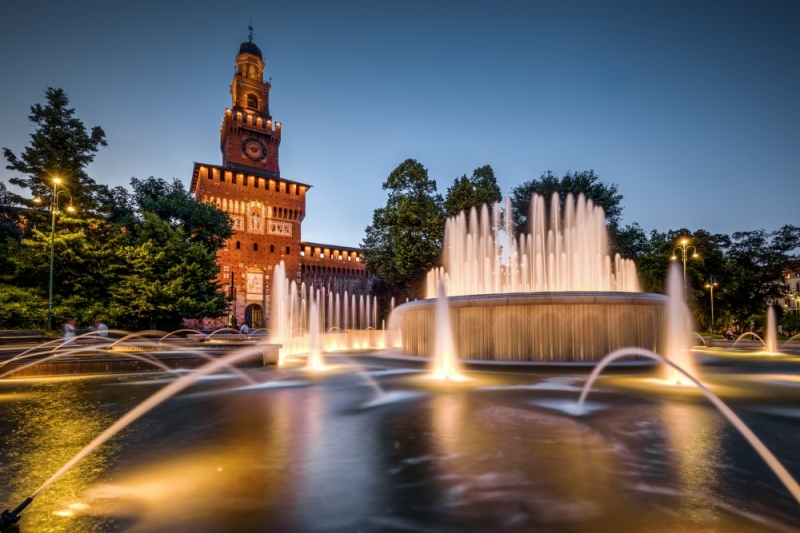
Sforzesco Castle - Milan
What see
Milan is certainly a great European Metropolis, a true heart of the Italian economy, with lots of things to see and do, with highly respected traditional cuisine and dishes, certainly recognized as the first real world fashion capital. Surely for a visit to Milan one cannot but start with Piazza Duomo, to continue towards the Galleria Vittorio Emanuele II, the La Scala theater, the Castello Sforzesco, the refectory of Santa Maria delle Grazie, where Leonardo left one of his greatest masterpieces: the Cenacle; then there is the beautiful church in neo-Romanesque style of San Babila. Finally, there is the international Milan, the one that attracts rich from all over the world with, above all, the streets of fashion, the windows of the big brands, splendid models walking and parked cars.
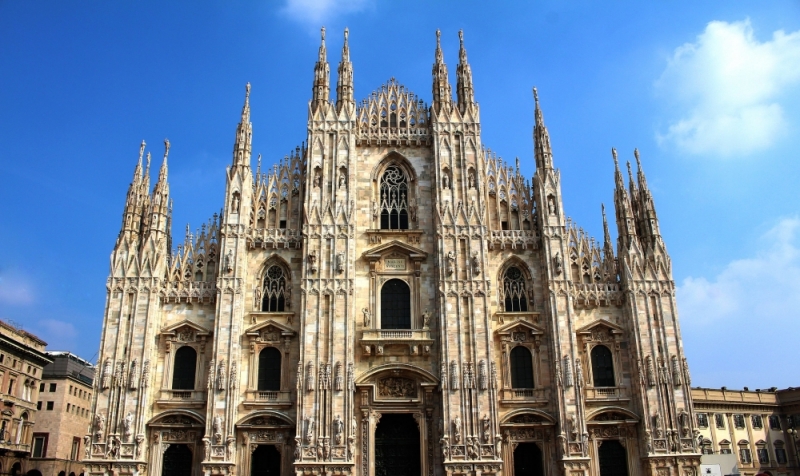
Duomo Milano - Image by inanimalis from Pixabay
Milan Cathedral
1) The Duomo of Milan is the largest basilica in Europe and its figures represent real record numbers: 157 meters long, 92 meters wide, 135 spiers with the largest 108.5 meters high, where the famous tall Madonna stands out 4 meters, completed by 3,500 statues, including the 96 gargoyle giants and one of the most beautiful gothic Lombard facade ever made. Dedicated to Santa Maria Nascente and built at the behest of Gian Galeazzo Visconti, the Cathedral has been the symbol of the city since 1386, the year in which the work began. It rises where once there were the ancient cathedral of Santa Maria Maggiore and the basilica of Santa Tecla. The material chosen for the construction was the Candoglia marble and the architectural forms were those of the late Gothic inspiration of Rhenish-Bohemian inspiration. We must, however, wait for 1805 and Napoleon Bonaparte for the completion of the façade, by Giuseppe Zanoia, which Napoleon wanted in anticipation of his Coronation as King of Italy, which took place on 6 May 1805. Throughout the nineteenth century there was the addition of statues and the erection of the spiers, by various architects (Pestagalli, Vandoni, Cesa Bianchi), inspired by the fifteenth-century spiers. Inside the Duomo, light filters through the 55 large windows inspired by the history of the most important Christian events and, still inside, not to be missed is the solar sundial located on the floor of the Cathedral of Milan, installed in 1786 from the abbots of the Brera observatory, which runs through the church from south to north with the various representations of the zodiac signs. Still inside, you should not miss the area of the presbytery, made new in the second half of the sixteenth century, and at the apex of the apse, the relic of the Holy Nail of the Cross. The impressive number of statues (2,500), which decorate the façade and the terraces of the Milan Cathedral, not only represent saints and blessed, but if you pay attention, for example, you will find a statue very similar to the Statue of Liberty in New York or the statue of a dinosaur, of a pigeon, but also two pairs of boxers intent on fighting, monstrous and demonic figures to frighten the "evil spirits" and the faces of some characters in the history of Italy, including Vittorio Emanuele III, Benito Mussolini and Pope Pius IX. Besides admiring the stupendous façade and the architecture from the outside of the Duomo (... and clearly the inside), do not miss the opportunity to climb the spiers (on foot or in an elevator) to admire the Madonnina up close, and for enjoy a spectacular view of Milan. Not to be overlooked is also the opportunity to visit the archaeological area under the Duomo and the attached Museum.
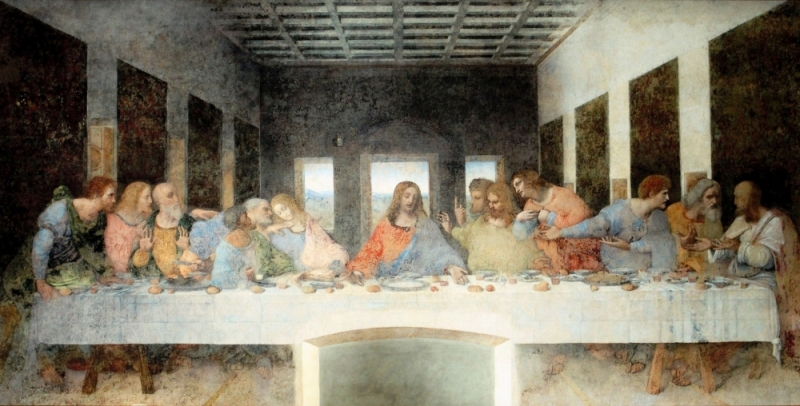
Milan - Leonardo da Vinci's Last Supper - Image by Markus Baumeler from Pixabay
Last Supper by Leonardo da Vinci
2) Realized between 1494 and 1498, the Last Supper by Leonardo da Vinci , inside the refectory of the Dominican convent of Santa Maria delle Grazie in Milan, is a maximum work for all humanity, which at least one time in life should be seen. Although the work has suffered heavy deterioration over time and clumsy interventions over the centuries, it is only thanks to the restoration work of 1999 that today, as then, we can admire the work in its original colors. If you want to see it, keep in mind that, to avoid that the painting can be damaged again, it is kept in particular environmental conditions and can be visited only by groups of maximum 25 visitors at a time, every 15 minutes.
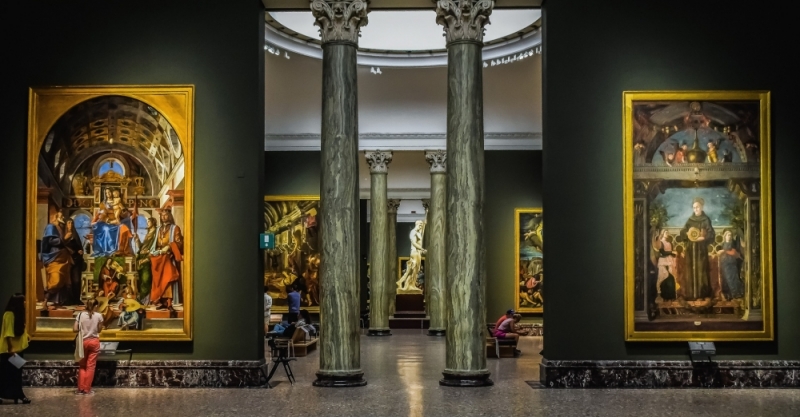
pinacoteca-di-brera - Photo by Dimitris Vetsikas from Pixabay
Brera 's picture gallery
3) The Pinacoteca di Brera was born in 1776 to house the collection of significant works for the training of the students of the Academy of Fine Arts . Milan, proclaimed capital of the Italic Kingdom by Napoleon, saw expropriated paintings arriving to churches and aristocrats and, those not brought to Paris, were preserved in Brera. The collection is very rich with some of the most famous works in the world: from the Cena in Emmaus by Caravaggio to the Dead Christ by Mantegna, from the Pala Brera by Piero della Francesca to the Marriage of the Virgin by Raphael. One of the symbols of Brera is the picture of Romanticism par excellence: the Kiss by Hayez. The collection reaches the 20th century with works by Braque, Modigliani, Picasso, Morandi, De Chirico and many others.

Milan Museum of 900 - photo by Marrabbio2
Museo del Novecento
4) The Museo del Novecento includes a collection of over 400 Italian works of art, ranging from the "Quarto Stato" by Giuseppe Pellizza da Volpedo to works by Picasso, Braque, Klee, Kandinskij and Modigliani, without neglecting Futurism, with Balla , Boccioni, Carrà, Depero, Severini and Soffici. The 1920s and 1930s are represented by De Chirico, Morandi and an entire space dedicated to Marino Marini. On the third floor there are works by informal artists, such as Burri, Vedova, Licini and others and from the 50s and 60s with Piero Manzoni and artists of Azimuth. The fourth floor is all for Lucio Fontana with the great "Soffitto Spaziale" of 1956, the Neon and the Space Concepts of the 50s. Here, from the large hall dedicated to Fontana, you can enjoy a spectacular view of the Duomo. The suspended walkway, which leads to the Royal Palace, is surrounded by works from the 1960s to the 1980s representing Kinetic and Programmed Art, Pop, analytical paintings and conceptual art with Kounellis, Paladino and others.
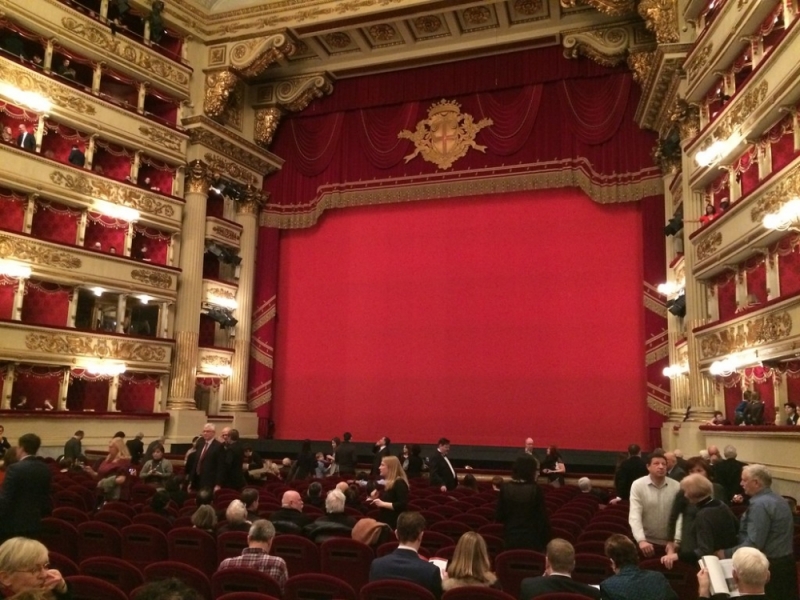
Teatro alla Scala Milan - photo Anna
Teatro alla Scala and adjoining museum
5) Teatro alla Scala and annexed Museum. In just two years, from 1776 to 1778, by the will of the Empress Maria Theresa of Austria and designed by the architect Giuseppe Piermarini, the Teatro alla Scala was born following the fire of the then Regio Ducale Theater. Named in honor of Beatrice Regina della Scala, wife of Bernabò Visconti, in 1943 it was heavily damaged by Allied bombing of the Royal Air Force. But already on 11 May 1946, after a very rapid reconstruction, the Teatro alla Scala reopened in its original splendor with a memorable concert directed by Arturo Toscanini. Visits to the Museum allow you to see the Theater Hall from the vantage point of the third-order boxes, the entrance foyer, the royal box, the historical boxes, even in the "behind the scenes", to discover the mechanism of the stage. Visits are held from Monday to Sunday. (they are possible only in the absence of shows or tests).
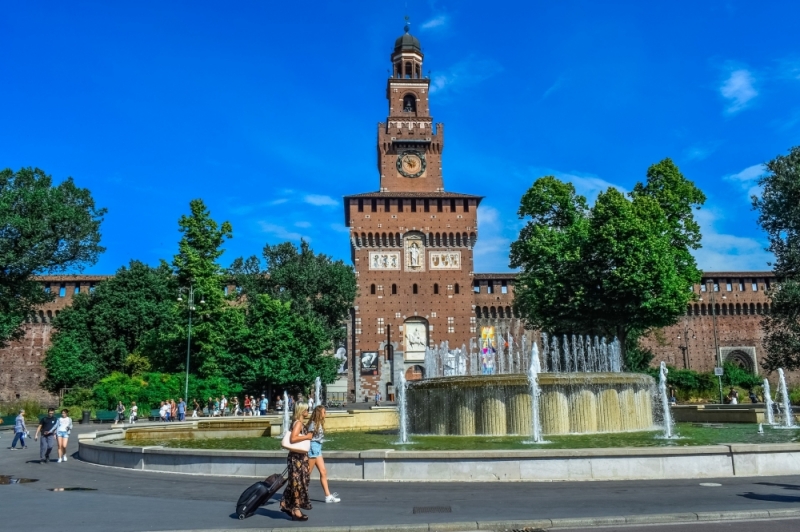
Milan Castello Sforzesco - Image by Dimitris Vetsikas from Pixabay
Sforzesco Castle
6) Castello Sforzesco has accompanied the history of Milan for 750 years. The first construction was commissioned by Galeazzo II, but it was Francesco Sforza (hence the name), who gave it its current shape. With the role of almost always a military citadel, today it is a place of culture, used to protect the testimonies of Lombard art. At present the Sforzesco Castle hosts on the ground floor the Museum of Ancient Art, on the first floor the collection of furniture and the Pinacoteca, on the first and second floor of the Rocchetta there are the collections of Applied Art and the Museum of Musical Instruments, in the basement of the Ducal Court there are the Museum of Prehistory and Proto-history and the Egyptian Museum. The Castle contains some masterpieces of Italian art: Michelangelo's Pietà Rondanini, Leonardo's frescoes in the VIII room of the Museum of Ancient Art, the Madonna in glory and Saints John the Baptist, Gregorio Magno, Benedetto and Gerolamo, by Mantegna, in the Pinacoteca and the extraordinary cycle of tapestries depicting the twelve months of Bramantino, in the Sala della Balla.
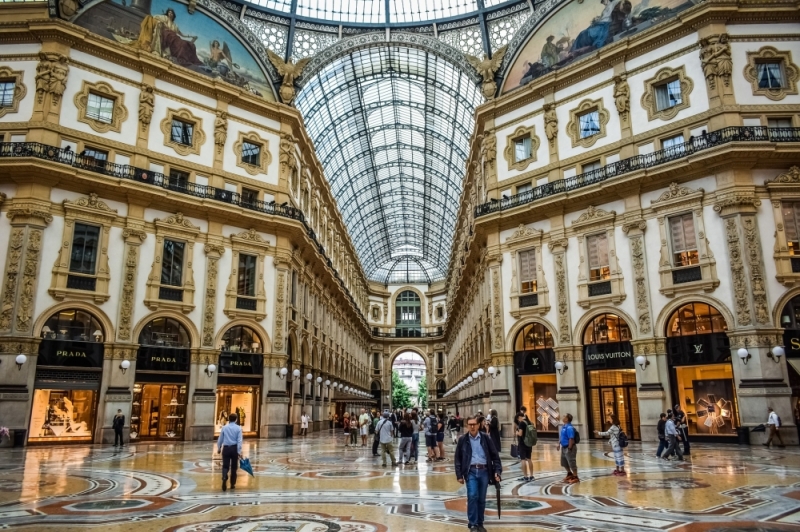
Milan Gallery - Photo by Dimitris Vetsikas from Pixabay
Galleria Vittorio Emanuele II
7) In 1859 the idea of a covered passage linking Piazza Duomo and Piazza della Scala cast the foundations for the subsequent construction of the Galleria Vittorio Emanuele II. In fact it is in this year that an international competition was held to evaluate the proposals of various architects (176) among which Giuseppe Mengoni's was chosen, who thought of a long gallery crossed by an arm, with a large octagonal hall in the center intersection. In 1865 with work by King Vittorio Emanuele II of Savoy, work began which lasted twelve years. The Gallery is traditionally the good living room of Milan, where you can meet to have a coffee.
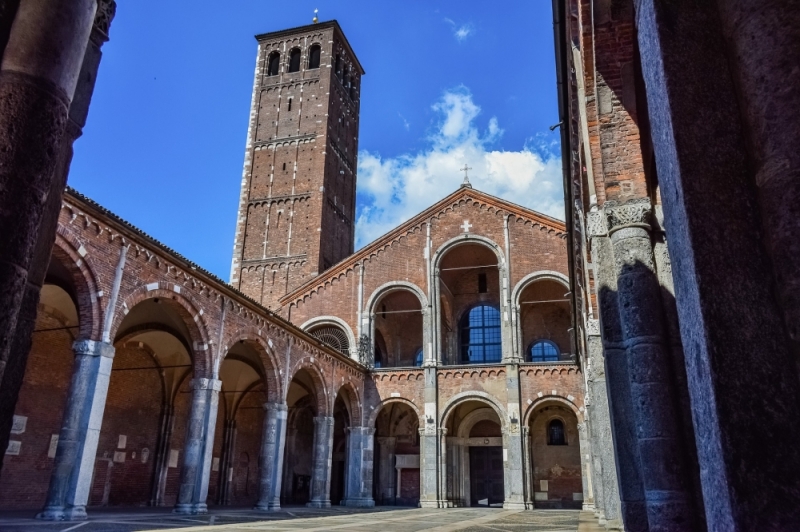
Milan Basilica of Sant'Ambrogio - Image by Dimitris Vetsikas from Pixabay
Basilica of Sant'Ambrogio
8) The Basilica of Sant'Ambrogio is the church dedicated to the patron saint of the city and is considered the second most important church, after the Duomo. Founded in the 4th century at the behest of Ambrogio, bishop of Milan (buried here in 397), the Basilica has a gabled façade characterized by two superimposed loggias and is framed by two bell towers, that of the Monks on the right, dating back to the 9th century, and that of the Canons , to the left, erected in the 12th century, with the exception of the last two planes added in 1889. Not to be missed in the presbytery is the ciborium from the 9th century, a canopy with Lombard-Byzantine stuccoes resting on four columns of red porphyry under which it is placed the Golden Altar, a masterpiece of Carolingian jewelry, the work of Vuolvino. The early Christian sarcophagus, known as the Stilicone sarcophagus dating from the 4th century, is also of great value. Inside the Ambrosian basilica you can admire the small chapel (sacellum) of San Vittore in Ciel d'Oro built in the 4th century, famous for the presence of early Christian mosaics on the walls and in the dome depicting some saints, including St. Ambrose.
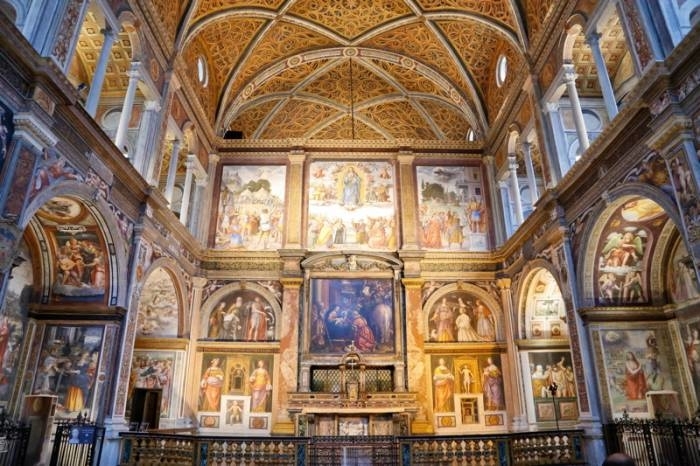
Milan church of San Maurizio at the Monastero Maggiore
Renaissance church of San Maurizio at the Monastero Maggiore
9) Built in the early 16th century on the ruins of an ancient place of worship, the Renaissance church of San Maurizio at the Maggiore Monastery , was annexed to the Maggiore Monastery of the Benedictine order (demolished in 1799), of which today the cloister of entrance, an integral part of the Archaeological Museum. On Corso Magenta it is rich in marvelous frescoes (a good 4 thousand square meters, mostly by Bernardino Luini) which cover the entire structure so much that the Sistine Chapel in Milan has been defined. We also find works by Simone Peterzano, master of Caravaggio, author of "The return of the prodigal son" and "Christ who hunts merchants from the temple" who decorate the interior facade of the church; to Antonio Campi we owe the "Adoration of the Magi" on the high altar. Of great value in the cloistered choir, the organ created by Gian Giacomo Antegnani (1557) originally intended for liturgical concerts, is now used for concert events in the city.
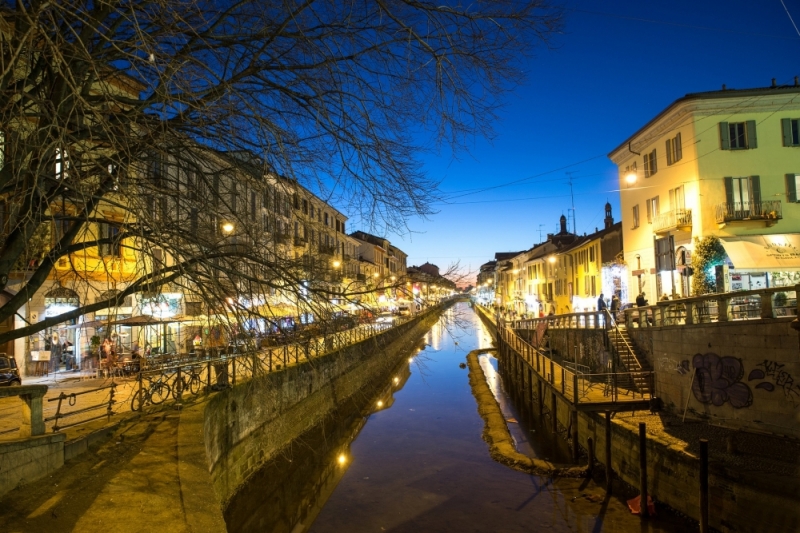
milano Navigli - Photo by pippocucu from Pixabay
Navigli
10) A stop on our tour of Milan certainly deserve the Navigli . Milan is a city of water and the Navigli system was born with the ambitious project of connecting the city, through real commercial waterways, with Lake Como, the Adda, Lake Maggiore and the Po , arriving in northern Europe and then up to the sea. The first canal, the Ticinello, was inaugurated in 1179 with a length of 50 kilometers. Even the genius of Leonardo Da Vinci was put to work on this hydraulic work. To him, in fact, we owe a brilliant system of locks, which allowed Milan to connect with Lake Como. Instead, it was Napoleon, in 1805, who completed the construction of the Naviglio Pavese for connection to the sea through the Po. The Navigli were protagonists of the life and development of Milan, but they also went through a dark era that saw them polluted, abandoned and sometimes even buried. Despite everything, today, fortunately, they are experiencing a renaissance and are at the center of numerous redevelopment projects. Bicycle lanes, boats, relaxation areas alongside the traditional taverns, the boutiques and artists' shops, are now considered a favorite area of the Milanese nightlife for the inevitable evening aperitif.
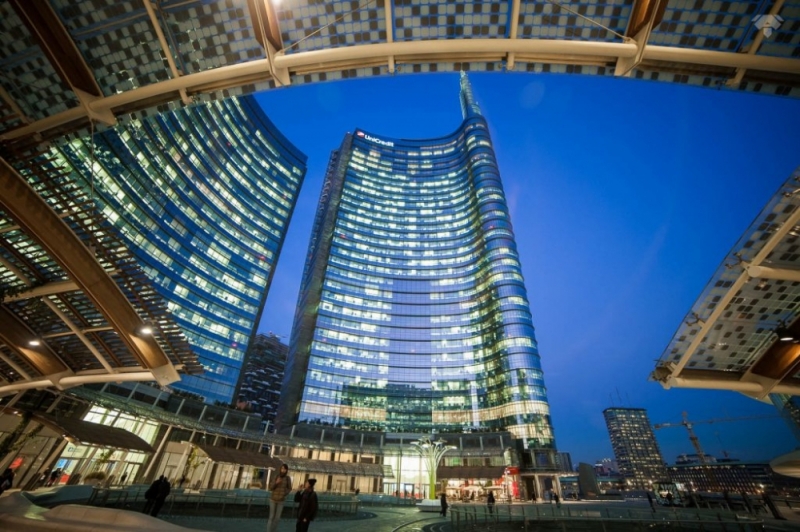
Milan neighborhood New door
Modern Milan
11) In recent years, Milan has had the need to add one more stage, namely that of Modern Milan, that of the Porta Nuova skyscrapers with the UniCredit Tower, Piazza Gae Aulenti and the Vertical Forest . On the occasion of the 2015 Expo, it experienced a real revival and revival that also had the effect of redeveloping and restyling some neighborhoods, including the Porta Nuova and Porta Garibaldi areas. The Unicredit Tower is the tallest skyscraper in Milan while Piazza Gae Aulenti is a circular square, about 100 meters in diameter, designed by the Argentine architect César Pelli, which has become the real new meeting point for the Milanese and not. The Bosco Verticale, on the other hand, is the first project of its kind in the world, a luxury residential complex, consisting of two buildings, completed in 2014, designed by the architect Stefano Boeri. The peculiarity of the two buildings are the over 2000 plants and trees that cover almost the entire exterior. It is a unique environmental project that has allowed a real metropolitan reforestation.
Fairs: Milan Capital of fashion
The Fairs deserve a chapter by themselves : Milan Capital of fashion - from January to March and from September to October, the Chamber of Fashion organizes events and events linked to the world of fashion, where Milan is invaded by top models , stylists, journalists, actors and politicians, becoming, if possible, even more worldly. The most important events, of course, are those dedicated to women's fashion. Another noteworthy Fair is the Craft Fair in December, which attracts many visitors eager to find original ideas for Christmas gifts, with products from all Italian regions, but also from Europe, Asia, Africa, Latin America . A special mention goes to the Salone del Mobile (in April), which occupies a net exhibition area of more than 255,000 and hosts 3100 of the most dynamic and creative companies on the international market with visitors from 150 countries around the world. In parallel with the exhibition, Fuorisalone is celebrated, an event also known as " Milan Design Week " and a reference point for the industrial design sector. It is accompanied by extravagant events that are often free. Don't miss them!
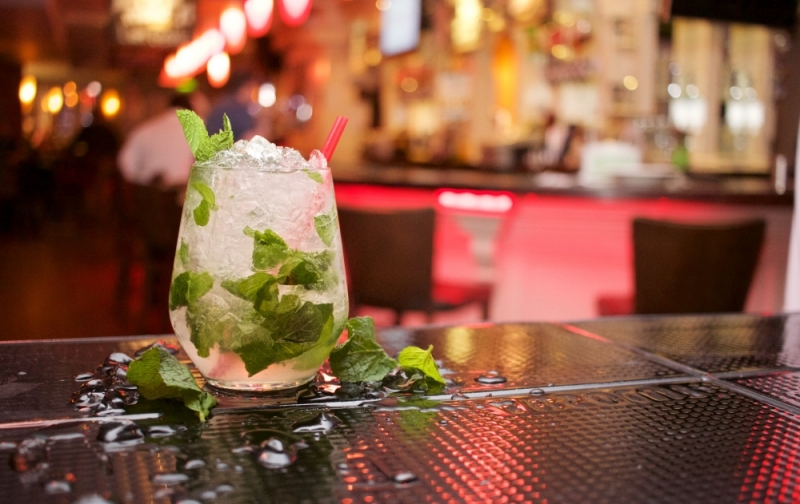
Aperitif Milan Bar - photo by pixels.com
Movida and entertainment
You will never get bored in Milan! It starts with an aperitif and then continue the evening in a nice place to spend all night dancing! There are so many of them and Corso Como is considered the street of nightlife with its famous nightclubs. In any case, whether it is summer with typical summer discos, outdoors (see Byblos) or winter with historical discos such as the Alcatraz, Hollywood, Magazzini Generali, Club Haus 80 (all Friday evening 80s), Amnesia, etc . surely the fun is guaranteed. In summer, in particular, the fun and the nightlife move to Milano Marittima, which in the evening becomes a large open-air venue thanks to its street bars, frequented by boys and tourists and where you can enjoy an aperitif after the beach or pass a evening with friends. The most popular nightclub is Pineta by Visionnaire, frequented by the famous faces of entertainment and sport, with dj sets of international appeal. For the younger ones, instead, there is Villa Papeete, connected to the Papeete beach, a bathing establishment where you can also dance on the beach. The areas of Milan where you can have an aperitif, are Zona Sempione, Navigli, Via Tortona and certainly the Brera area of Milan. But not only that, in the last few years also the Isola area, near Piazzale Lagosta and also the whole part of the city between Via Valtellina and Via Farini is very crowded for happy hour. For an aperitif followed by a Baja California-style dinner I would recommend Mexicali, otherwise you can go to the sushi-beer restaurant on Isola Della Birra. If you wanted to eat a good sushi without giving up the drink I would say Soho Cafè in Via Farini. Also in this area, there is the Chiringuito which, if you are a fun person in Milan, is a must for those who love hip-hop, while a must-see if you love live bands is the Nord Est Cafè, in via Borsieri . A special quote goes to the famous Blue Note, a place that has hosted the most famous jazz musicians of the world and still today is a popular destination, where you can enjoy a cocktail while listening to great music. If, on the other hand, you are looking for rivers of beer, Città Studi is the area for you (targets from 20 to 30 years) with clubs such as the Union Club and Brasserie Bruxelles in Viale Abruzzi, while for high-level beers there is Au Vieux Strasbourg in Strambio street.
Drinking the aperitif is now time for dinner and in Milan there is really the embarrassment of the choice because, as Cultural and Business Capital, even in food it offers a real multinational and multiethnic choice. But Milan, like the rest of Italy, also boasts a great culinary tradition and therefore the advice is to choose a restaurant or a trattoria of typical cuisine. Real king of Milanese cuisine, know that it is butter, with which most of the dishes are prepared, from risotto, to Milanese cutlet, to panettone. You can't not eat an excellent Milanese risotto, made with saffron and carnaroli rice from the nearby rice fields of Pavia. The traditional one is expected to be served with the hole bone, where the delicious part is the marrow. Typically Milanese is also the "busecca" (stewed rippa) and the famous "Milanese cutlet", the "cassoeula" instead (very rich dish with cabbage and the "poor" parts of the pig) and among the desserts the panettone and the Dove. And don't be surprised, though, if at the end of the meal, instead of dessert or fruit, they ask you to serve yourself a taste of excellent local cheeses such as: stracchino, mascarpone, Lodi grana and, of course, gorgonzola.
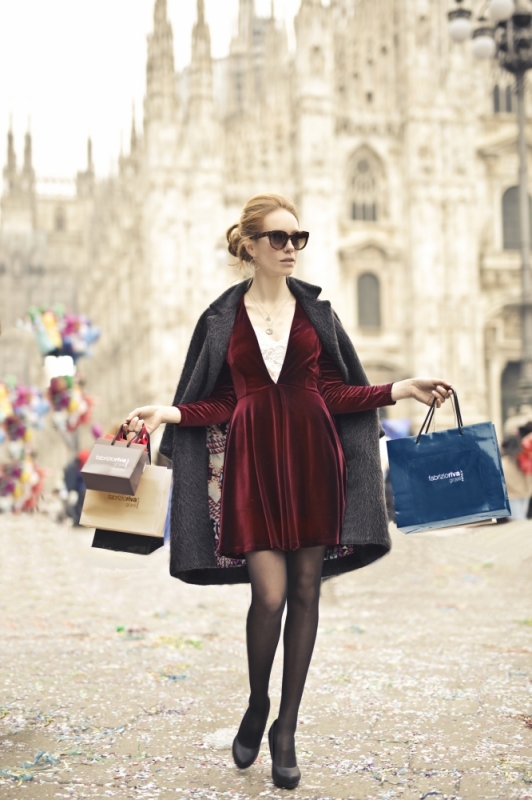
Shopping in Milan
Photo by bruce mars from Pexels
Climate, Curiosities and Advice
Climate: The climate of Milan, the capital of Lombardy, situated to the west of the Val Padana basin, is characterized by a humid temperate climate, with a notable temperature range with very hot summers and cold winters. The humidity reigns here all year (minimum 70% in March and July with peaks up to 84% in December) with possible fogs, particularly in the southern part. Milanese winters are colder than those in coastal cities. The winter climate is quite peculiar, with days of low temperatures (-2 / + 5 °) and high humidity alternating with very mild and dry days. Summers are hot (+ 20 ° / + 33 °), decidedly sultry and not very windy, but affected by different thunderstorms that attenuate the scorching atmosphere: the months between June and August are in fact fairly rainy. Even the intermediate seasons and especially the mid-autumn and spring are rainy.
Trivia: Are you looking for some luck? Then it is quickly done: in the center of the Galleria Vittorio Emanuele II you will find the mosaic of a bull. Place only the heel of the right foot on the genitals of the bull (the rest of the foot must not touch the ground) and turn 3 times on yourself. If you believe strongly fortune will be immediately to you!
Did you know that the Duomo of Milan, which began to be built in 1386 and that, through works that lasted for the next five centuries, was finished, in the facade as we see it today, only in 1836? It is adorned with 3400 statues and sculptures and not all of them represent saints or figures of the Bible, but among them there is also common genete. And you also knew that his little Madonna, 4.16 meters high and covered with 6750 gold sheets, during the Second World War, was covered with rags, to prevent the reflections of light on its golden surface could be used as a reference point for bombers? And did you know that it is the halberd that he holds in his right hand (already this curious thing thinking he is a madonna) and that it is in fact a lightning rod?
Organizing a party or a romantic dinner on a tram? in Milan you can: Orange trams are one of the symbols of Milan that contribute to give charm to the city and with a little money and a large advance it is possible to organize private parties in the evening along an established route.
A curiosity about the basilica of Sant'Ambrogio and its Roman column located nearby: on it there are two holes made, according to legend, by Satan. It is said that the devil, having failed to seduce Ambrogio, tried to pierce him but struck the column remaining stuck with his long horns. Angry, in the form of sulfur fumes, the evil one used those same holes to return to the underworld. Do not worry, therefore, if from those holes you feel a slight smell of sulfur coming out or if leaning your ear you hear strange noises coming from them.
Tips: Surely if you are in Milan you will want to visit the Duomo, the third largest church in the world, and therefore I cannot give you any advice: The terraces are accessible every day from 9:00 to 19:00 and the last entrance is at 18:00. Tickets for the Duomo can be purchased at the official ticket office located at the foot of the church. If you suffer from heights know that the terraces are about 70 meters high, but surely you can enjoy the beautiful panorama of Milan and also the privilege of being able to closely observe the famous Madonnina and all the statues that adorn the spiers. Sunset time is the best time for romantics and photo-lovers.
To get there the roads are 2: the first, for the more sporty, via a staircase with 251 steps, the second through a comfortable lift.
Always at the Duomo, I suggest you also visit the underground archaeological area and the beautiful Duomo museum. In the archaeological part you will be able to see the remains of the first churches on which the Cathedral was built: Santa Tecla (from the early Christian era, with five naves) and the ancient basilica dedicated to Santa Maria Maggiore. In the Museum, instead, you will find all the projects, the remains and the removed parts of the various historical periods. I recommend not leaving Milan before having tasted a slice of traditional Panettone and taking a walk along Via Monte Napoleone, the fashion street par excellence, where you can admire the windows of luxury brands, capturing the extravagance of customers who frequents them.
How to get around: definitely by public transport and the excellent Metro: therefore, if you arrive by car leave it at one of the interchange car parks, while if you arrive by train you can easily access one of the Metro lines.




























